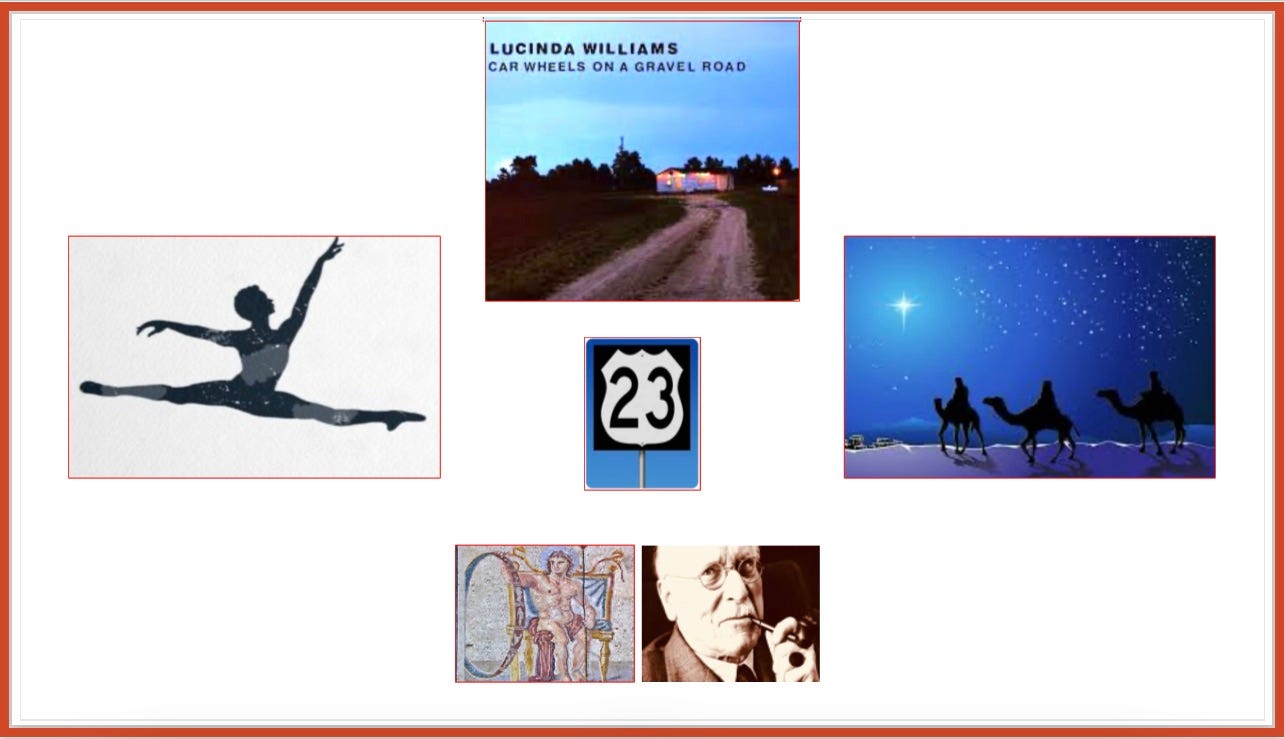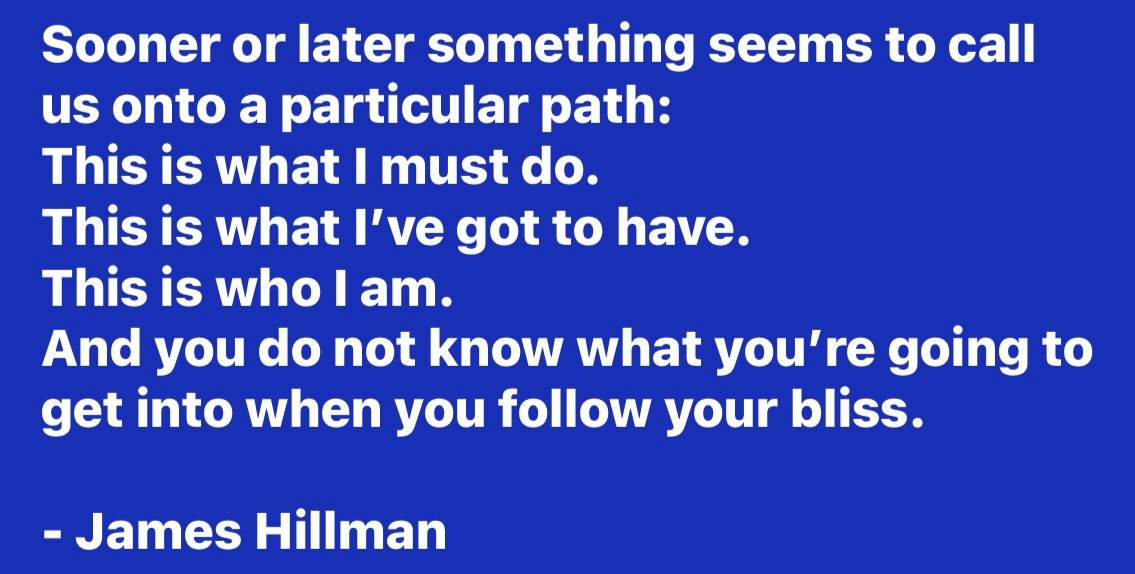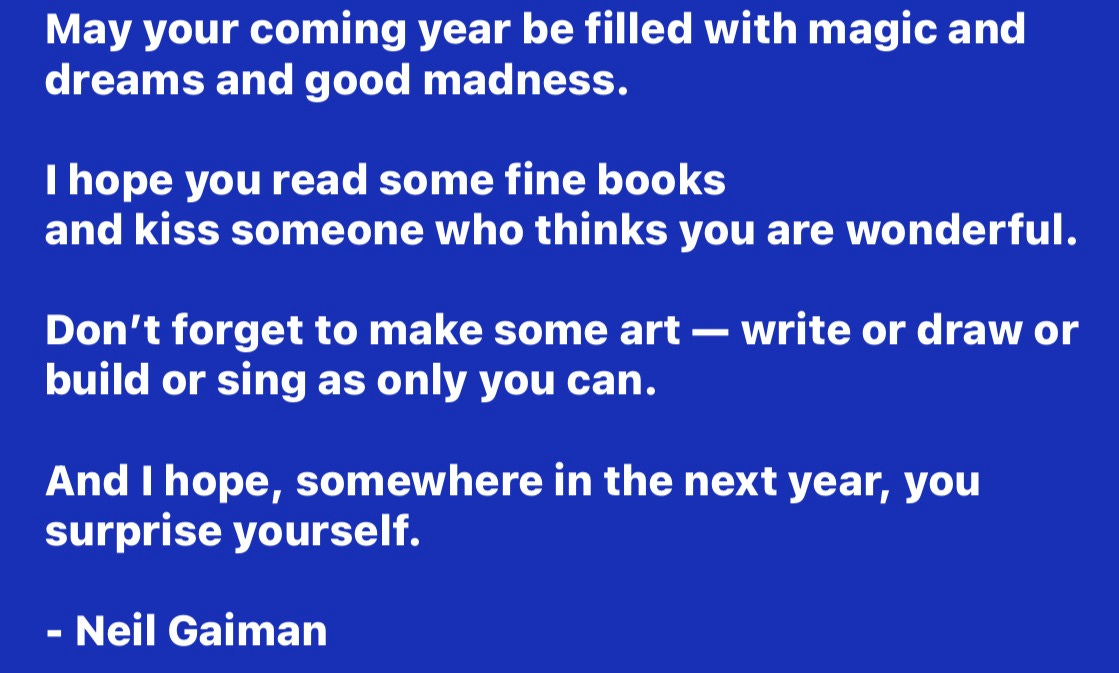🐇🐇 First-of-the-month rabbit-rabbit luck, and Happy New Year!
As you who’ve been readers awhile may recall, I usually tend more pensive than partying at New Year’s. And Epiphany on January 6, the “twelfth night” this Friday, is a significant time — both in perspectives of depth/soul psychology and for me personally.
Next week’s focus returns to what is sure to be a lively start to the news-year, along with a couple of evolving new periodic newShrink features.
musical notes
Continuing the spirit of last week’s holiday photo gallery here is a brief visual tour of a few from that frequent feature: A few of the music, song-title and lyric earworms from the psyche that have become a kind of newShrink soundtrack. (Musical images and quotes included as visuals last week aren’t repeated here.)
These are pictured as a reminder of the many varied forms and ways the unconscious psyche/soul informs and moves our human stories forward — right alongside factual logic of ideas expressed in words, data and measurement. As with last week’s visuals, these are chosen as they showed up for me, by no particular criteria — at least no conscious ones!
Along with observing the threshold from 2022 into 2023 this edition incorporates some favorite material from last New Year’s that I find still freshly meaningful. Today’s title themes capture some elements:
🔷 natural interplay between New Years and Epiphany’s common themes of linear and eternal-cyclical time, new beginnings, uncharted paths ahead, synchronistic epiphanies and the tensions and leaps of faith they generate.
🔷 light-and-shadow/darkness connections with depth psychology;
🔷 the storied journey of the Magi — strangers drawn toward a mystery, guided in hope and faith to follow a star;
🔷 rich Epiphany lore from classical mythology and pagan versions of the story;
🔷 an array of cross-cultural celebration, theatre, arts and literature that depict and celebrate the Epiphany story; and
🔷 writers and thinkers who have pondered and developed the idea and felt- experience of epiphany as a psychological process, turning points in our human situations and stories.
At center-column above:
right-in-time
Borrowing a song title from hauntingly gravel-voiced Lucinda Williams (top center column above), here at the cusp of new year and old seems a natural point for considering the core concepts and imagery of time in depth/soul-focused psychology. There’s a constant interplay and dance of dynamic tension between linear Chronos (clock and “resume”) time and the more cyclical eternal or soul time.
This latter was apparently so important for Jung that he adopted the mythological Greek god Aion (pictured with Jung at bottom center) as descriptive title metaphor of his volume 9ii (a Part 2 volume) of the Collected Works. In the Greek pantheon Aion is god of Eternity, whose domain includes the cyclical time of the zodiac year. He also is often depicted and considered to be standing “over” Chronos or linear time.
As for that ‘23 marker at center, Jung also had a great deal to say about the symbolism and dynamic nature of numbers (www.jungiancenter.org.:
Jung thought of numbers as archetypes and, as such, they were ‘pre-existent to consciousness.’ They were not something humans invented, but were more something we ‘found or discovered.” In a footnote in the essay “On the Nature of the Psyche,” Jung noted that ‘A [pythagorean] mathematician once remarked that everything in biology and science was man-made except numbers, which had been created by God himself.” (sources: www.jungiancenter.org and Jung’s Collected Works Volume 8, The Structure and Dynamics of the Psyche.)
This quirky story has some lighter (and a few woo-woo) stories about the new year’s number 23:
23 fascinating facts about the number twenty-three (www.independent.co.uk/news)
To most, it's just what comes between 22 and 24. Yet to surprisingly many — including the makers of a new film — it means much more. Cahal Milmo and Tom Willetts explore a bizarre obsession.
🔵
Looking now to left photo above…
leaps and new beginnings
Timely and worth noting, IMPEL was a Wordle solve word this week!
Psychology, particularly of the depth/soul-engaged kind, has many references, images and theoretical processes involving leaps of faith. Usually at best disruptive of usual rhythms, these are situations that confront and engage us with the unconscious soul, particularly its least-known shadowy aspects previously unknown to us about ourselves.
Especially in our era’s popularity of so-called positive ego psychology, the phrase leap of faith can take on a jaunty or a what-the-heck tone. From the depth perspective this doesn’t capture the complexity, enormous discipline and painful holding of opposites such transformative change can involve for a person going through it.
Even sound-bite versions of key ideas from the mythologist Joseph Campbell, whose work has so influenced depth psychology, can be used mistakenly to emphasize adventure minus the hard work. For example, his “Follow your bliss…” can seem like the graceful leaping dancer in the photo above…
… while in depth psychology process the “holding the tension of opposites” the soul demands can look and feel more like either an abduction to the abyss — or, at best, a Coach Yogi Berra conundrum, anything to get us off the cliff:
When you come to a fork in the road, take it.
This one from Campbell is a little better at capturing both the inspirational push and the reality when we’re facing the fearsome dilemmas our growth sometimes demands:
A bit of advice given to a Native American at the time of his initiations: As you go the way of life, you will see a great chasm. Jump. It is not as wide as you think.
(Well, if there weren’t a chasm, it wouldn’t be much of an initiation, epiphany or a leap, now would it?!)
As usual, I like best the way James Hillman captures both light and shadow aspects of these soul-engaged leap moments:
Shifting from psychology to such leaps in literature, another recent Wordle-solve, POISE, points to a kind of romantic readiness mentioned here in a long-favorite quote from F. Scott Fitzgerald. In The Great Gatsby, narrator Nick Carraway introduces the title character Jay Gatsby:
…”there was something gorgeous, some heightened sensitivity to the promises of life, as if he were related to one of those intricate machines that can register earthquakes ten thousand miles away. This responsiveness had nothing to do with the flabby impressionability which is dignified under the name of ‘creative temperament’ —it was an extraordinary gift for hope, a romantic readiness such as I have never found in any other person and it is not likely I shall ever find again. No—Gatsby turned out all right in the end…”
Now, as illustrated above at right…
🔵
epiphanies
From a consensus of major dictionaries, the word epiphany is derived from the Greek epiphaneia, which means manifested, or showing.
… across cultures
This New York Times seasonal feature story from 2018 offers a colorful cross-section:
Epiphany Celebrations Around the World (pictured above starting in left column.)
The Three Wise Men greet children during a Twelfth Night procession in Pamplona, Spain. (Credit: Villar Lopez/European Pressphoto Agency.)
The Twelfth Night procession in Madrid includes fireworks over City Hall. (Credit...Mariscal/European Pressphoto Agency)
Orthodox Christians in Kalofer, Bulgaria, dive into freezing water to retrieve a wooden crucifix, a tradition dating from Byzantine times. (Credit: Dimitar Dilkoff/Agence France-Presse — Getty Images.)
A Rosca de Reyes, or kings’ ring, fit for an Epiphany crowd is served in Mexico City. (Credit: Daniel Becerril/Reuters.)
An Epiphany swim for Orthodox Christians off a beach near Athens is less bracing than those in Bulgaria or Russia. (Credit: Louisa Gouliamaki/Agence France-Presse — Getty Images.)
…in religions
The original uses of the word arose from both the familiar Christian Christmas story marking and celebrating the arrival of the Biblical Magi who follow a prominent star from afar to honor Jesus and other mythological pagan stories with remarkably similar elements.
The capitalized-version Epiphany has come to refer to the religious celebration date, now primarily in Christian context and in commemoration events.
…in psychology
The familiar Epiphany story from Christianity has many common threads across different cultures’ faith traditions — some much older, the Greeks, for example.
With some astonishing parallels to Christianity’s familiar Magi Epiphany story, Jung presents a detailed account of pagan festivals held on the night of Epiphany, January 5/6. These were in Alexandria and elsewhere according to the writings of Epiphanius of Salanis, Cypress. He was a 4th Century Bishop considered a saint and church father of both Eastern Orthodox and Roman branches of the Catholic Church. (Last New Year’s 1.1.22 edition of newShrink, has a more detailed account that some of you may find interesting.)
… in literature and the arts
The second, lower-case version of epiphany has also become a common description of both the literary device and the felt psychological experience of a turning point in the story, a character (or oneself.)
Our epiphanies are those moments where we have realized awareness, a new knowing, after which events are seen through the prism of this new light. (from literary devices.net.)
James Joyce’s ahas
Between 1898 and 1904 the ground-breaking Irish novelist Joyce (a contemporary of Jung pictured at center column above) created literary epiphanies as a non-fiction prose genre. They were a series of short “snapshot” pieces without much connective narrative. Epiphany was figuring prominently as a literary device by the time he was working on earlier versions of his famed Portrait of the Artist as a Young Man with autobiographical character Stephen Dedalus. Later Dedalus reappears in Ulysses. (The following is from literary terms.com.)
Joyce sounds very like Jung in his observation that our epiphanies are “a sudden and momentary showing forth of one’s authentic inner self.”
Joyce’s brother Stanislaus’s letters describe epiphanies as more like Freudian slips, ways in which we unconsciously “give our more authentic selves away.” (This view also echoes Jung’s caveat: That the unconscious shadow we do not bring to light appears in our external lives, unbidden.)
Joyce’s description of the epiphany as the aha moment sounds like Jung’s soul spark. In The Divine Comedy a series of these mark Dante’s path, as he makes his descent and emergence through hell and back. From Joyce:
“[with epiphanies] the soul of the commonest object, the structure of which is so adjusted, seems to us so radiant.. Unlike foreshadowing, epiphany occurs not necessarily by connection with the rest of plot or story, and suddenly, as if divinely inspired.”
Here, Joyce’s ideas echo those of Rudolph Otto and William James on the nature of numinous (most simply, soul-engaged) experience:
Characters are rooted in everyday life, but epiphanies allow them to rise above ordinary consciousness in order to have revelations and realizations that demand and lead them with a changed perspective.
As is the way of fictional chracters, these described experiences can help us understand ourselves as well. That is what brings them to life for us, giving storytelling such power for connection, creative problem-solving and transformative change.
On this topic the bard leaves us an enduring statement…
William Shakespeare
One of Shakespeare’s most-performed plays is The Twelfth Night, set and often performed as part of celebrations of Epiphany. As a comedy it’s generally expected to have a happy ending, which it does for most of its many characters.
🔵
coming soon
As mentioned in a recent post, the ancient city of Petra, Jordan, continues to pique my study- and writing-interest on several levels.
Petra is a vibrantly alive, present-day destination site I visited some years ago. It’s also literally a tomb, unearthed archaeological artifacts, relics and ghosts of what as yet is only a 1% portion of an enormous, nearly 3,000-year-old — dead — city in the middle of the most remote of Arabian deserts. And from the newShrink archetypal and symbolic perspectives of the soul’s depth psychology, Petra presents rich and useful metaphor for understanding the unconscious and our individuation paths.
Petra appearances in newShrink will likely begin, um, surfacing no sooner than late January. I would love to hear from any of you with a passion and/or experience with archaeology and antiquities, and/or those who have visited and are willing to share Petra experiences and insights.
🔵
closing notes…
lucky months
Those 🐇🐇 first-moments-of-the-month-lucky rabbit-rabbits call on a good-luck charm and symbol of good luck, health and fertility, like a rabbit’s foot. The monthly ritual has surfaced in both British and American folklore over the past century. Historically I’ve enjoyed picturing FDR’s reported practice of the rabbit-rabbit monthly ritual over decades, and his always carrying a rabbit’s foot. And just out last month, favorite mystery novelist Louise Penny’s latest Armand Garmache volume opens with a main character’s noting of a rabbit rabbit morning.
From a depth psychology perspective in personal practice, I find this works best as a monthly night-owl morning ritual a moment after midnight. Whenever we wake at or before dawn, we tend to be in a treasured liminal state. That is peak-time essential for recall and attending to what the psyche and dreams are serving-up. In that time and space, rabbit-rabbit becomes both challenge and lower priority!
thresholds
Jung had much to say regarding those flying-leaps-of-faith — sometimes precipices — of initiation that life’s soul-individuation process puts in our path. Aptly, I think, he noted that not everybody individuates — or has the slightest desire or inclination to! It’s disruptive. By their very nature the thresholds put us increasingly out of our comfort zones — beyond “playing to our strengths.”
For some of us individuation has been unavoidable. As the late Jungian Marion Woodman wryly observed: None of us gets up one morning and says, “Hey, I’m going to go become a deeper, more whole and authentic person today…” No, she continued, “Most of us must be dragged to it kicking and screaming like pigs to the slaughter!”
From years of close work with people who brave the daunting, untangling process in practice — and from my own life observation and experience — I believe, intensely, that each of our soul-beckoning thresholds, flying-leaps-of-faith demanded along our paths — however benign or excruciating while underway— is a gift. And when we have managed to deny, bypass or bury them, we and the vital life-sparks that animate and define us are diminished and dimmed.
gifts & gratitude
With that in mind, again I leave you with my Happy You Year wishes for:
🔷 an extraordinary gift for hope… heightened sensitivity to the promises of life…
🔷 a psyche-soundtrack full of musical morning Joy, with scores yet to be heard…
and, as needed and appropriate,
🔷 the infinite depth-psychology wisdom of Coach Yogi Berra: When you come to a fork in the road, take it.
As posted from longtime newspaper friend Pat:
I am so thankful to you for reading newShrink, for sharing yourself with me via ideas and material, and I look forward to hearing from you in the new year ahead.
And, that is all I have! Talk to you next week.
🦋💙tish
… it is important that awake people be awake,
or a breaking line may discourage them back to sleep;
the signals we give — yes or no, or maybe —
should be clear: the darkness around us is deep.
— William Stafford, “A Ritual to Read to Each Other”








